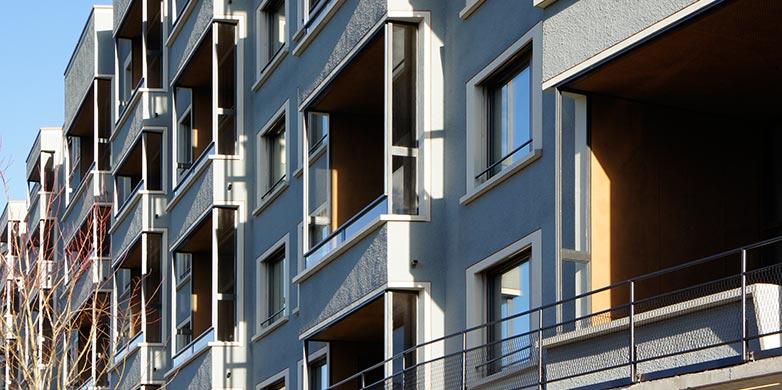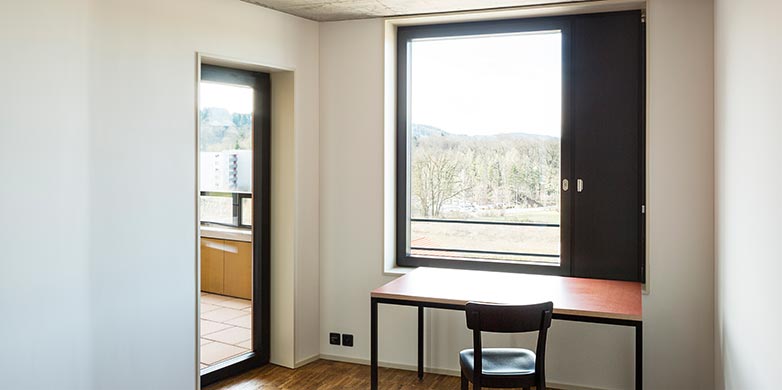Minergie standard for student homes
Accommodation for students in Zurich is in short supply. The number of students joining the University of Zurich and ETH Zurich increases every year. Today sees the official opening of Zurich’s biggest student hall of residence, with 332 low-priced rooms.
Starting at university is often associated with moving away from the parental home. For most students, it is a step towards independence, because commuting is barely worthwhile and also tiring after a day’s studying. Of course, it would be ideal for every student to live as close as possible to the campus, or within easy reach of it. The accommodation must not be too expensive, since studying is usually funded by the student’s parents. This is no easy undertaking, because the cost of living in the city of Zurich is high. This is why the Student Housing Foundation (SSWZ) was created in 1987 − a partnership between ETH Zurich, the University of Zurich, the City of Zurich and the Student Housing Cooperative Zurich (external pageWOKOcall_made). It set itself the goal of tackling the shortage of student accommodation.
Tried and tested flat-sharing concept
The SSWZ offers students a reasonably priced room, with seven to fifteen students living in one flat and sharing a kitchen, bathroom and sitting room. “We evaluate every building project, and try to improve new projects,” says Rebecca Taraborrelli of the SSWZ. She was responsible for the Aspholz project. This consists of 332 rooms in 41 flats in a seven-storey building. The flat-sharing concept is economical and so far has apparently proved very successful. The feedback from most of the students living in a flat is good. “The allocation is OK,” says ETH student Julian. “There are some rooms that are only for Erasmus students, but seven living in a flat works very well. It feels more like student life.” He finds it a shame, however, that the Erasmus flatmates only stay for one term.
The hall of residence has been occupied since February and the students in the building have now set up external pagea closed Facebook groupcall_made, where they discuss day-to-day problems or announce the next party. “The seclusion of the hall of residence is a plus point,” says one resident. For one thing, students can get out easily at any time to the nearby Katzensee lake, and, for another, they can have parties without disturbing the neighbourhood or even neighbours inside the house. This makes it an attractive area in which to live. The communal rooms have also been designed so that the neighbours are disturbed as little as possible if it does get a bit noisy sometimes.
Good location
The attractive location was also regarded as an advantage in the feasibility study which was carried out right at the start. The foundations for the Aspholz hall of residence were laid in 2010, when planning for this major project first began. The building work began two years ago and was completed in February of this year. The student block is in a good location. Another criterion was the ease of access to the universities. The bus route close to the building takes students to the university in just half an hour, whether that is the Hönggerberg campus, which is the closest, or the Irchel campus. And the local area offers more than just easy access to their place of study, because just outside the front door is a Coop, where students can stock up with food until 8 p.m. in the evening.
Reasonably priced rooms
On average, a room like this costs 500-600 francs, which is really cheap, says one student who lives in the Aspholz building. Admittedly, he was paying slightly less before, but his old flat was in a residential district, somewhat smaller and, because of its age, much less well insulated for sound than his new WOKO flat. Sustainable building is a high priority for the SSWZ: that’s why this new hall of residence is well insulated from motorway noise and was built to the MINERGIE-P-ECO standard. As well as the 41 flats there are also recreation rooms, music rooms, guest rooms, laundries and bicycle rooms in the building.
“What is a bit unusual,” says Taraborrelli, “is that this building has no basement. Instead, each student has a storage space that can be used as the tenant wishes.” Consequently, the laundry and the 288 bicycle parking places are on the ground floor. “There’s not much to complain about,” says one resident. “The laundry is on the small side, but we manage somehow, as long as not everyone wants to do their washing at the same time.”
At 39 million francs, however, this hall of residence was still a low-cost project. Rebecca Taraborrelli is very pleased. “We were able to build to a high quality but still cut costs.” The next big project is another more central hall of residence in the Wipkingen district, which is not so large but will still provide accommodation for a further 130 students.
Aspholz opening ceremony
Now that the project has been successfully completed, and is fully occupied, the Aspholz student hall of residence on the Cäsar-Ritz-Strasse in Affoltern will be officially opened on 17 June 2014. Between 3.30 p.m and 6 p.m., there will not only be speeches by Andreas Fischer, Vice-President of the Student Housing Foundation and former Rector of the University of Zurich, and former City Councillor Martin Vollenwyder, but also guided tours to demonstrate the architecture, building services and domestic engineering. This will be followed by a public viewing of the World Cup match. The celebrations are not open to the public. Booking is essential.


